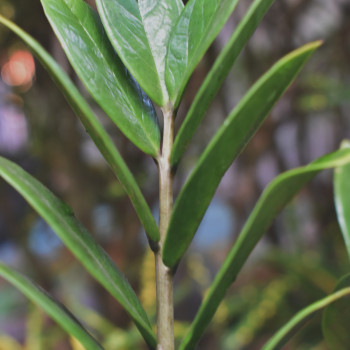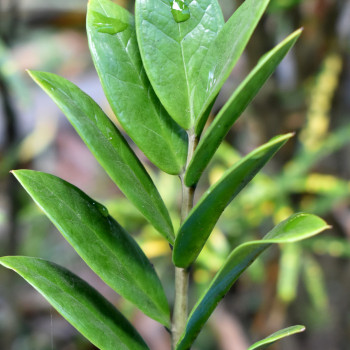Emerald palm

Scientific Name :
Zamioculcas zamiifolia (Lood) Eng.
Synonym(s) :
Zamioculcas lanceolata Peter
Local/Common name(s) :
Emerald palm
Family :
Araceae
Habit :
Herb
Flowering/Fruiting Time :
Habitat :
Humid to dry evergreen forest, Brachystegia woodland, dry wooded grassland, bushland thicket, often on rocks, locally abundant.
Endemic :
No
Status (IUCN) :
Distribution :
A monotypic genus endemic to eastern and south-eastern tropical Africa; Mozambique, Zimbabwe, Malawi, South Africa (Natal) Hab.
Nativity :
Exotic
Uses :
Ornamental, Medicine
Description (Morphology) :
Tuber subcylindric, ± 3-4 cm in diameter or more, tough, woody. Petiole green with darker transverse blotches, 15-35 cm long, 1-2 cm in diameter near base; blade 20-40 cm long; leaflets 4-8 per side, subopposite, distant, oblong-ovate to -elliptic to -obovate, sometimes oblanceolate, fleshy, dark glossy green, 5-15 cm long, 1.5-5 cm broad, shortly acuminate, sessile or shortly petiolulate, articulated to rhachis, cuneate to rounded basally; rhachis terete, marked like petiole. Peduncle 3-20 cm long, 0.4-1 cm in diameter, erect at first recurving strongly in fruit, pushing infructescence into ground-litter. Spathe 5-8 cm long, coriaceous; tube shortly cylindric to ellipsoid, 1-1.5 cm long, 1-2 cm in diameter, green on outer surface; limb broadly oblong-ovate, 5-6 cm long, 3.5-5.5 cm broad, rounded and cuspidate at tip, pale green to whitish or yellow. Spadix 5-7 cm long; staminate part cylindric to clavate, 4-5 cm long, 1-1.5 cm in diameter, narrowed at base; pistillate part shortly cylindric-ellipsoid, 1-2 cm long, 0.7-1.7 cm in diameter. Tepals white; stigmas yellowish. Berry white, surrounded by persistent tepals, with septal suture, up to 1.2 cm broad, 1-2-seeded. Seeds brown, ellipsoid, ± 0.8 cm long, 0.5 cm.



